Impact of Tea and Coffee Consumption on Cognitive Performance: An fNIRS and EDA Study
Abstract
1. Introduction
2. Method
2.1. Participants
2.2. Experimental Procedure
2.3. EDA (Electrodermal Activity) Signal Acquisition and Analysis
2.4. fNIRS (Optical Brain Monitoring) Signal Acquisition and Analysis
2.5. Statistical Analysis
3. Results
3.1. Self-Reports
3.1.1. Beverage Likeability
3.1.2. Confidence in Task Performance
3.2. Behavioral Performance
3.2.1. Task Performance
3.2.2. Beverage Consumption
3.3. Electrodermal Activity
3.4. Neural Efficiency
3.4.1. Math Neural Efficiency
3.4.2. RVP (Rapid Visual Processing) Neural Efficiency
3.4.3. Stroop Neural Efficiency
4. Discussion
Author Contributions
Funding
Conflicts of Interest
References
- Wang, Y.; Ho, C.-T. Polyphenolic chemistry of tea and coffee: A century of progress. J. Agric. Food Chem. 2009, 57, 8109–8114. [Google Scholar] [CrossRef]
- Grigg, D. The worlds of tea and coffee: Patterns of consumption. GeoJournal 2002, 57, 283–294. [Google Scholar] [CrossRef]
- Nehlig, A. Are we dependent upon coffee and caffeine? A review on human and animal data. Neurosci. Biobehav. Rev. 1999, 23, 563–576. [Google Scholar] [CrossRef]
- Stroebaek, P.S. Let’s have a cup of coffee! Coffee and coping communities at work. Symb. Interact. 2013, 36, 381–397. [Google Scholar] [CrossRef]
- Waber, B.N.; Olguin, D.O.; Kim, T.; Pentland, A. Productivity through coffee breaks: Changing social networks by changing break structure. Soc. Sci. Res. Netw. 2010. [Google Scholar] [CrossRef]
- Mancini, E.; Beglinger, C.; Drewe, J.; Zanchi, D.; Lang, U.E.; Borgwardt, S. Green tea effects on cognition, mood and human brain function: A systematic review. Phytomedicine 2017, 34, 26–37. [Google Scholar] [CrossRef]
- Shukitt-Hale, B.; Miller, M.; Chu, Y.-F.; Lyle, B.J.; Joseph, J.A. Coffee, but not caffeine, has positive effects on cognition and psychomotor behavior in aging. AGE 2013, 35, 2183–2192. [Google Scholar] [CrossRef]
- Lyvers, M.; Brooks, J.; Matica, D. Effects of caffeine on cognitive and autonomic measures in heavy and light caffeine consumers. Aust. J. Psychol. 2004, 56, 33–41. [Google Scholar] [CrossRef]
- Van Dam, R.M.; Hu, F.B. Coffee consumption and risk of type 2 diabetes. JAMA 2005, 294, 97–104. [Google Scholar] [CrossRef]
- Wierzejska, R. Can coffee consumption lower the risk of Alzheimer’s disease and Parkinson’s disease? A literature review. Arch. Med. Sci. 2017, 13, 507–514. [Google Scholar] [CrossRef]
- Steffen, M.; Kuhle, C.; Hensrud, D.; Erwin, P.J.; Murad, M.H. The effect of coffee consumption on blood pressure and the development of hypertension: A systematic review and meta-analysis. J. Hypertens. 2012, 30, 2245–2254. [Google Scholar] [CrossRef] [PubMed]
- Panza, F.; Solfrizzi, V.; Barulli, M.R.; Bonfiglio, C.; Guerra, V.; Osella, A.R.; Seripa, D.; Sabba’, C.; Pilotto, A.; Logroscino, G. Coffee, tea, and caffeine consumption and prevention of late-life cognitive decline and dementia: A systematic review. J. Nutr. Health Aging 2015, 19, 313–328. [Google Scholar] [CrossRef] [PubMed]
- Buckenmeyer, P.J.; Bauer, J.A.; Hokanson, J.F.; Hendrick, J.L. Cognitive influence of a 5-h ENERGY(R) shot: Are effects perceived or real? Physiol. Behav. 2015, 152, 323–327. [Google Scholar] [CrossRef] [PubMed]
- Smit, H.J.; Rogers, P.J. Effects of ‘energy’ drinks on mood and mental performance: Critical methodology. Food Qual. Prefer. 2002, 13, 317–326. [Google Scholar] [CrossRef]
- Warburton, D.; Bersellini, E.; Sweeney, E. An evaluation of a caffeinated taurine drink on mood, memory and information processing in healthy volunteers without caffeine abstinence. Psychopharmacology 2001, 158, 322–328. [Google Scholar] [CrossRef]
- Alford, C.; Cox, H.; Wescott, R. The effects of red bull energy drink on human performance and mood. Amino Acids 2001, 21, 139–150. [Google Scholar] [CrossRef]
- Curtin, A.; Ayaz, H. Neural efficiency metrics in neuroergonomics: Theory and applications. Neuroergonomics 2019, 133–140. [Google Scholar] [CrossRef]
- Haier, R.J.; Siegel, B.; Tang, C.; Abel, L.; Buchsbaum, M.S. Intelligence and changes in regional cerebral glucose metabolic rate following learning. Intelligence 1992, 16, 415–426. [Google Scholar] [CrossRef]
- Neubauer, A.C.; Fink, A. Fluid intelligence and neural efficiency: Effects of task complexity and sex. Personal. Individ. Differ. 2002, 35, 811–827. [Google Scholar] [CrossRef]
- Sayala, S.; Sala, J.B.; Courtney, S. Increased neural efficiency with repeated performance of a working memory task is information-type dependent. Cereb. Cortex 2006, 16, 609–617. [Google Scholar] [CrossRef]
- Neubauer, A.; Fink, A. Intelligence and neural efficiency. Neurosci. Biobehav. Rev. 2009, 33, 1004–1023. [Google Scholar] [CrossRef] [PubMed]
- Di Domenico, S.; Rodrigo, A.H.; Ayaz, H.; Fournier, M.A.; Ruocco, A.C. Decision-making conflict and the neural efficiency hypothesis of intelligence: A functional near-infrared spectroscopy investigation. Neuroimage 2015, 109, 307–317. [Google Scholar] [CrossRef] [PubMed]
- Paas, F.; Van Merriënboer, J.J.G. The efficiency of instructional conditions: An approach to combine mental effort and performance measures. Hum. Factors 1993, 35, 737–743. [Google Scholar] [CrossRef]
- Nielsen Global Health and Wellness Report (2015). We are What we Eat: Healthy Eating Trends Around the World; Nielsen: New York, NY, USA, 2015.
- Bhatt, S.; Agrali, A.; Suri, R.; Ayaz, H. Does comfort with technology affect use of wealth management platforms? usability testing with fnirs and eye-tracking. Adv. Intell. Syst. Comput. 2019, 775, 83–90. [Google Scholar]
- Ayaz, H.; Dehais, F. Neuroergonomics: The Brain at Work and Everyday Life, 1st ed.; Elsevier Academic Press: Cambridge, MA, USA, 2019. [Google Scholar]
- Parasuraman, R.; Christensen, J.; Grafton, S. Neuroergonomics: The brain in action and at work. Neuroimage 2012, 59, 1–3. [Google Scholar] [CrossRef] [PubMed]
- Curtin, A.; Ayaz, H. The age of neuroergonomics: Towards ubiquitous and continuous measurement of brain function with fnirs. Jpn. Psychol. Res. 2018, 60, 374–386. [Google Scholar] [CrossRef]
- Gramann, K.; Fairclough, S.H.; Zander, T.O.; Ayaz, H. Editorial: Trends in neuroergonomics. Front. Hum. Neurosci. 2017, 11, 165. [Google Scholar] [CrossRef]
- McKendrick, R.; Parasuraman, R.; Murtza, R.; Formwalt, A.; Baccus, W.; Paczynski, M.; Ayaz, H. Into the wild: Neuroergonomic differentiation of hand-held and augmented reality wearable displays during outdoor navigation with functional near infrared spectroscopy. Front. Hum. Neurosci. 2016, 10, 216. [Google Scholar] [CrossRef]
- Gateau, T.; Ayaz, H.; Dehais, F. In silico vs. over the clouds: On-the-fly mental state estimation of aircraft pilots, using a functional near infrared spectroscopy based passive-BCI. Front. Hum. Neurosci. 2018, 12, 187. [Google Scholar] [CrossRef]
- Pinti, P.; Aichelburg, C.; Gilbert, S.; Hamilton, A.; Hirsch, J.; Burgess, P.; Tachtsidis, I. A review on the use of wearable functional near-infrared spectroscopy in naturalistic environments. Jpn. Psychol. Res. 2018, 60, 347–373. [Google Scholar] [CrossRef]
- Topoglu, Y.; Watson, J.; Suri, R.; Ayaz, H. Electrodermal activity in ambulatory settings: A Narrative Review of Literature. In Advances in Neuroergonomics and Cognitive Engineering; Springer: Berlin/Heidelburg, Germany, 2020; pp. 91–102. [Google Scholar]
- Benedek, M.; Kaernbach, C. A continuous measure of phasic electrodermal activity. J. Neurosci. Methods 2010, 190, 80–91. [Google Scholar] [CrossRef]
- Boucsein, W. Electodermal Activity; Springer Science & Business Media: New York, NY, USA, 2012. [Google Scholar]
- Ayaz, H.; Izzetoglu, M.; Platek, S.; Bunce, S.; Izzetoglu, K.; Pourrezaei, K.; Onaral, B. Registering fNIR data to brain surface image using MRI templates. In Proceedings of the 2006 International Conference of the IEEE Engineering in Medicine and Biology Society, New York, NY, USA, 30 August–3 September 2006; pp. 2671–2674. [Google Scholar] [CrossRef]
- Ayaz, H.; Shewokis, P.A.; Bunce, S.; Izzetoglu, K.; Willems, B.; Onaral, B. Optical brain monitoring for operator training and mental workload assessment. Neuroimage 2012, 59, 36–47. [Google Scholar] [CrossRef]
- Ayaz, H.; Shewokis, P.A.; Curtin, A.; Izzetoglu, M.; Izzetoglu, K.; Onaral, B. Using MazeSuite and Functional Near Infrared Spectroscopy to Study Learning in Spatial Navigation. J. Vis. Exp. 2011, 2011, e3443. [Google Scholar] [CrossRef]
- Addicott, M.A.; Yang, L.L.; Peiffer, A.M.; Burnett, L.R.; Burdette, J.H.; Chen, M.Y.; Hayasaka, S.; Kraft, R.A.; Maldjian, J.A.; Laurienti, P.J. The effect of daily caffeine use on cerebral blood flow: How much caffeine can we tolerate? Hum. Brain Mapp. 2009, 30, 3102–3114. [Google Scholar] [CrossRef]
- Brunyé, T.T.; Mahoney, C.R.; Lieberman, H.R.; Giles, G.E.; Taylor, H.A. Acute caffeine consumption enhances the executive control of visual attention in habitual consumers. Brain Cogn. 2010, 74, 186–192. [Google Scholar] [CrossRef]
- Frary, C.D.; Johnson, R.K.; Wang, M.Q. Food sources and intakes of caffeine in the diets of persons in the United States. J. Am. Diet. Assoc. 2005, 105, 110–113. [Google Scholar] [CrossRef]
- Hindmarch, I.; Quinlan, P.T.; Moore, K.L.; Parkin, C. The effects of black tea and other beverages on aspects of cognition and psyhomotor performance. Psychopharmacology 1998, 139, 230–238. [Google Scholar] [CrossRef]
- Brice, C.; Smith, A. Effects of caffeine on mood and performance: A study of realistic consumption. Psychopharmacology 2002, 164, 188–192. [Google Scholar] [CrossRef]
- Camfield, D.; Stough, C.K.; Farrimond, J.; Scholey, A. Acute effects of tea constituents L-theanine, caffeine, and epigallocatechin gallate on cognitive function and mood: A systematic review and meta-analysis. Nutr. Rev. 2014, 72, 507–522. [Google Scholar] [CrossRef]
- Nehlig, A. Is caffeine a cognitive enhancer? J. Alzheimers Dis. 2010, 20, S85–S94. [Google Scholar] [CrossRef]
- Rizwan, A.; Zinchenko, A.; Özdem, C.; Rana, S.; Al-Amin, M. The effect of black tea on human cognitive performance in a cognitive test battery. Clin. Phytosci. 2017, 3, 13. [Google Scholar] [CrossRef][Green Version]
- Borgwardt, S.; Hammann, F.; Scheffler, K.; Kreuter, M.; Drewe, J.; Beglinger, C. Neural effects of green tea extract on dorsolateral prefrontal cortex. Eur. J. Clin. Nutr. 2012, 66, 1187–1192. [Google Scholar] [CrossRef] [PubMed]
- Field, D.T.; Williams, C.M.; Butler, L.T. Consumption of cocoa flavanols results in an acute improvement in visual and cognitive functions. Physiol. Behav. 2011, 103, 255–260. [Google Scholar] [CrossRef] [PubMed]
- Socci, V.; Tempesta, D.; Desideri, G.; De Gennaro, L.; Ferrara, M. Enhancing Human Cognition with Cocoa Flavonoids. Front. Nutr. 2017, 4, 19. [Google Scholar] [CrossRef]
- Sokolov, A.N.; Pavlova, M.A.; Klosterhalfen, S.; Enck, P. Chocolate and the brain: Neurobiological impact of cocoa flavanols on cognition and behavior. Neurosci. Biobehav. Rev. 2013, 37, 2445–2453. [Google Scholar] [CrossRef]
- Nehlig, A. The neuroprotective effects of cocoa flavanol and its influence on cognitive performance. Br. J. Clin. Pharmacol. 2013, 75, 716–727. [Google Scholar] [CrossRef]
- Kennedy, D.O.; Scholey, A.; Wesnes, K. Modulation of cognition and mood following administration of Ginkgo biloba, ginseng, and a ginkgo/ginseng combination to healthy young adults. Physiol. Behav. 2002, 75, 739–751. [Google Scholar] [CrossRef]
- Elsabagh, S.; Hartley, D.E.; Ali, O.; Williamson, E.; File, S.E. Differential cognitive effects of Ginkgo biloba after acute and chronic treatment in healthy young volunteers. Psychopharmacology 2005, 179, 437–446. [Google Scholar] [CrossRef]
- Cieza, A.; Maier, P.; Pöppel, E. Effects of Ginkgo biloba on mental functioning in healthy volunteers. Arch. Med. Res. 2003, 34, 373–381. [Google Scholar] [CrossRef]
- Persson, J.; Nyberg, L. The memory-enhancing effects of Ginseng and Ginkgo biloba in healthy volunteers. Psychopharmacology 2004, 172, 430–434. [Google Scholar] [CrossRef]
- Brunyé, T.T.; Mahoney, C.R.; Lieberman, H.R.; Taylor, H.A. Caffeine modulates attention network function. Brain Cogn. 2010, 72, 181–188. [Google Scholar] [CrossRef]
- Kenemans, J.; Wieleman, J.S.; Zeegers, M.; Verbaten, M.N. Caffeine and Stroop Interference. Pharmacol. Biochem. Behav. 1999, 63, 589–598. [Google Scholar] [CrossRef]
- Lorist, M.; Snel, J.; Kok, A.; Mulder, G. Acute effects of caffeine on selective attention and visual search processes. Psychophysiology 1996, 33, 354–361. [Google Scholar] [CrossRef]
- Lorist, M.M.; Snel, J. Caffeine effects on perceptual and motor processes. Electroencephalogr. Clin. Neurophysiol. 1997, 102, 401–413. [Google Scholar] [CrossRef]
- Kenemans, J.L.; Verbaten, M.N. Caffeine and visuo-spatial attention. Psychopharmacology 1998, 135, 353–360. [Google Scholar] [CrossRef]
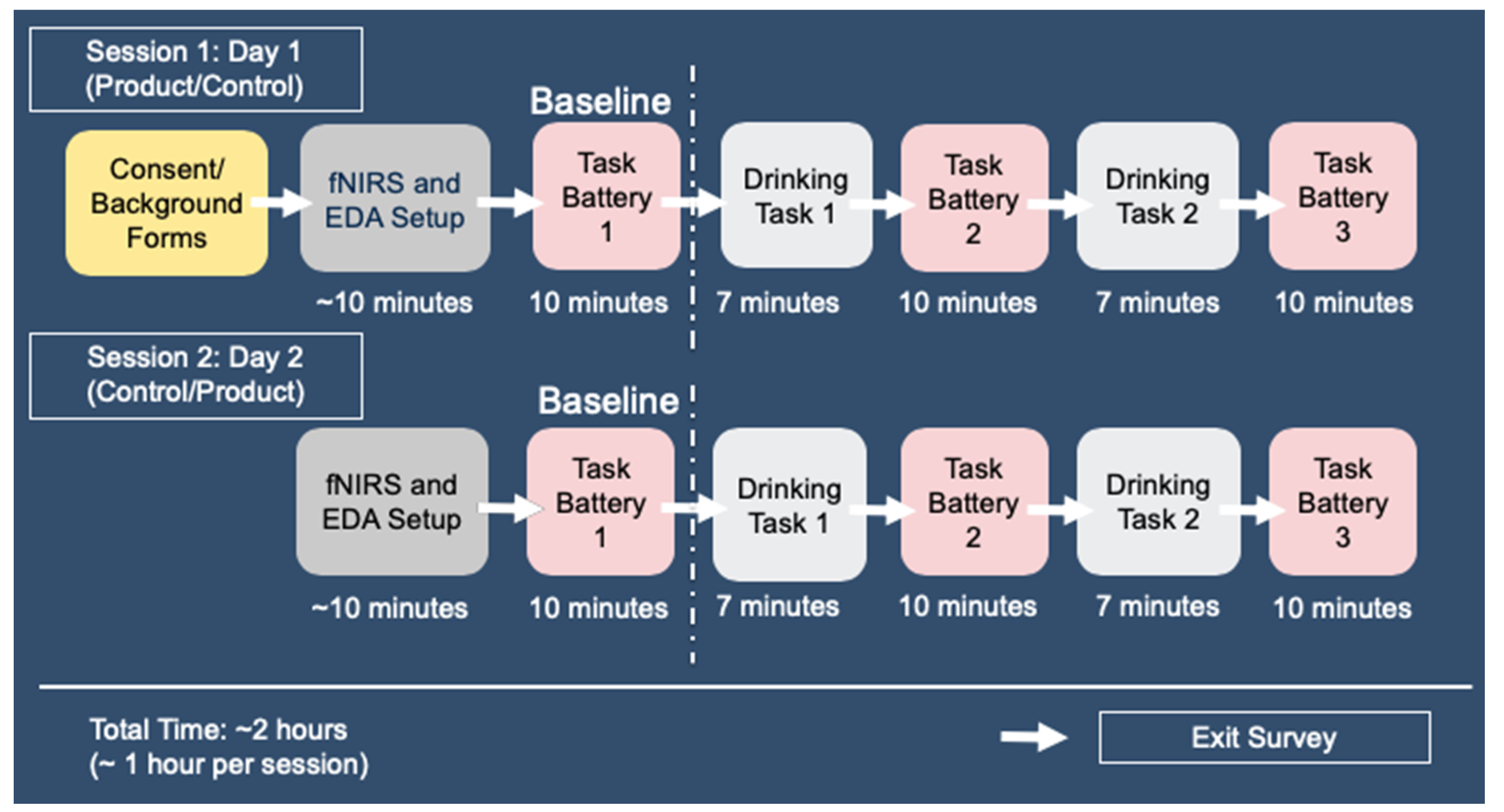
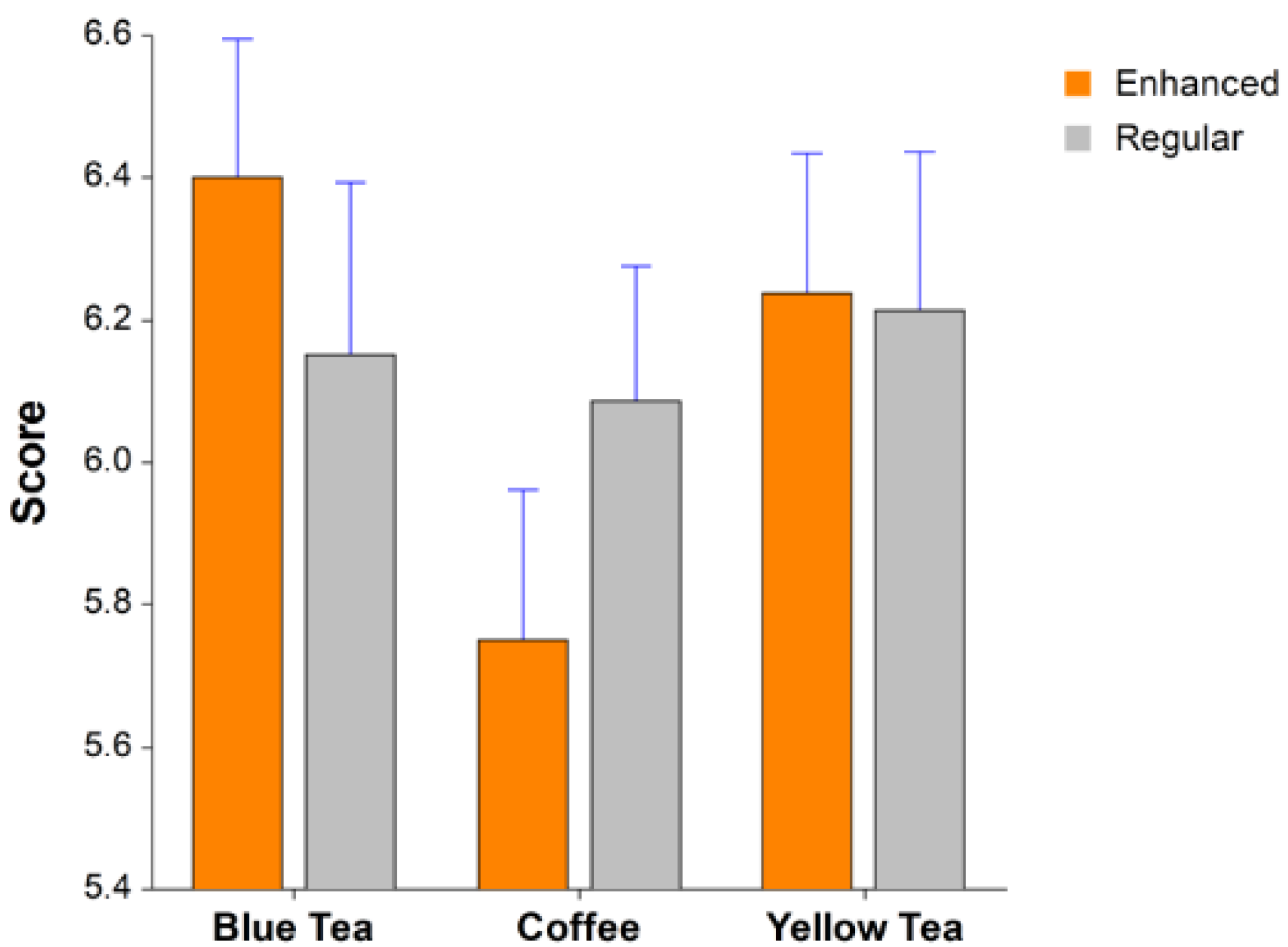
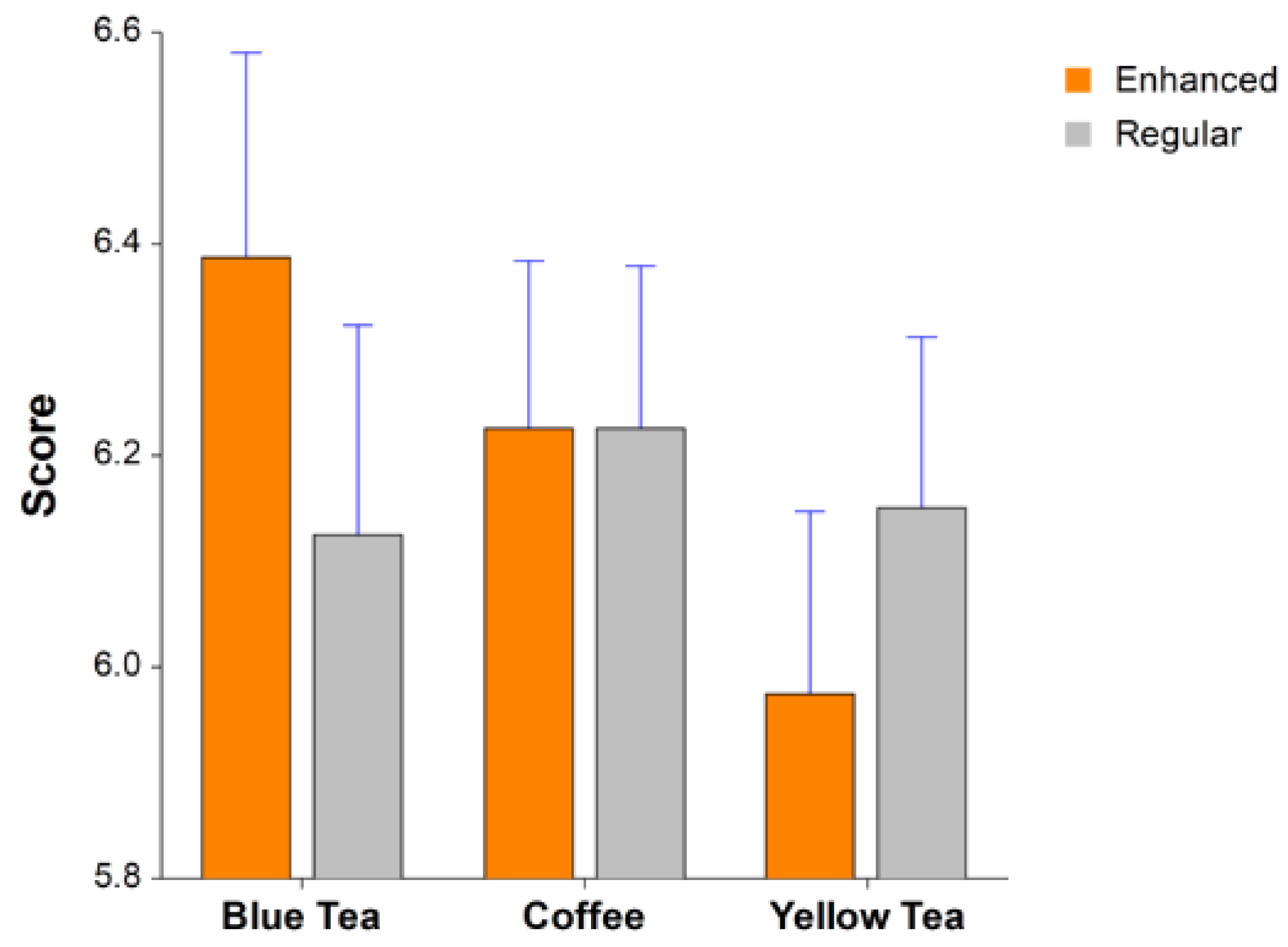
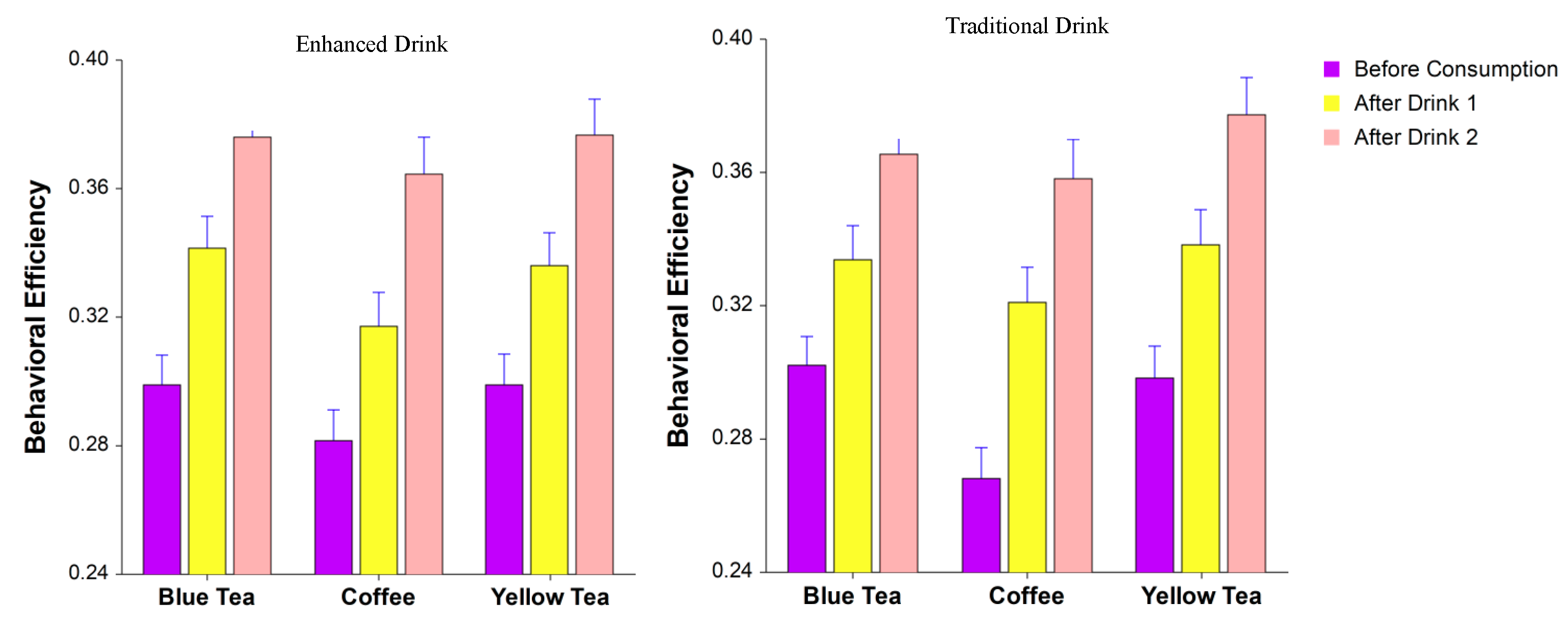
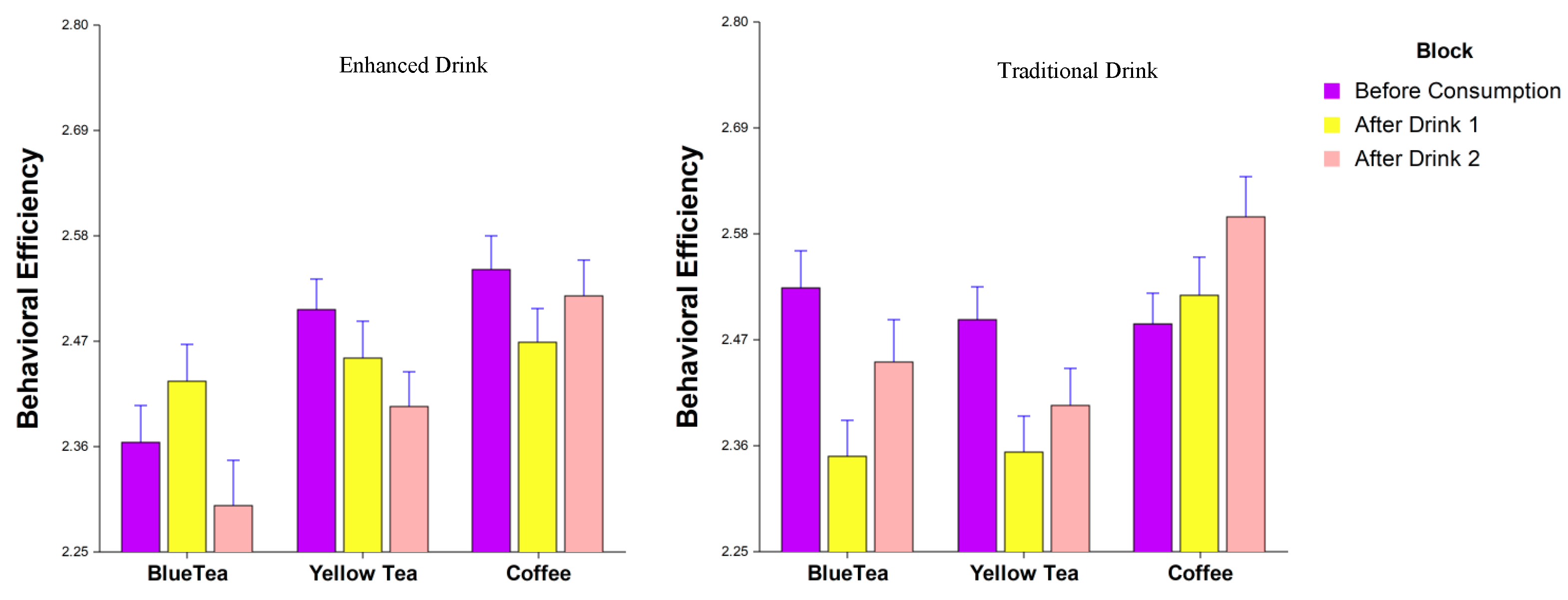
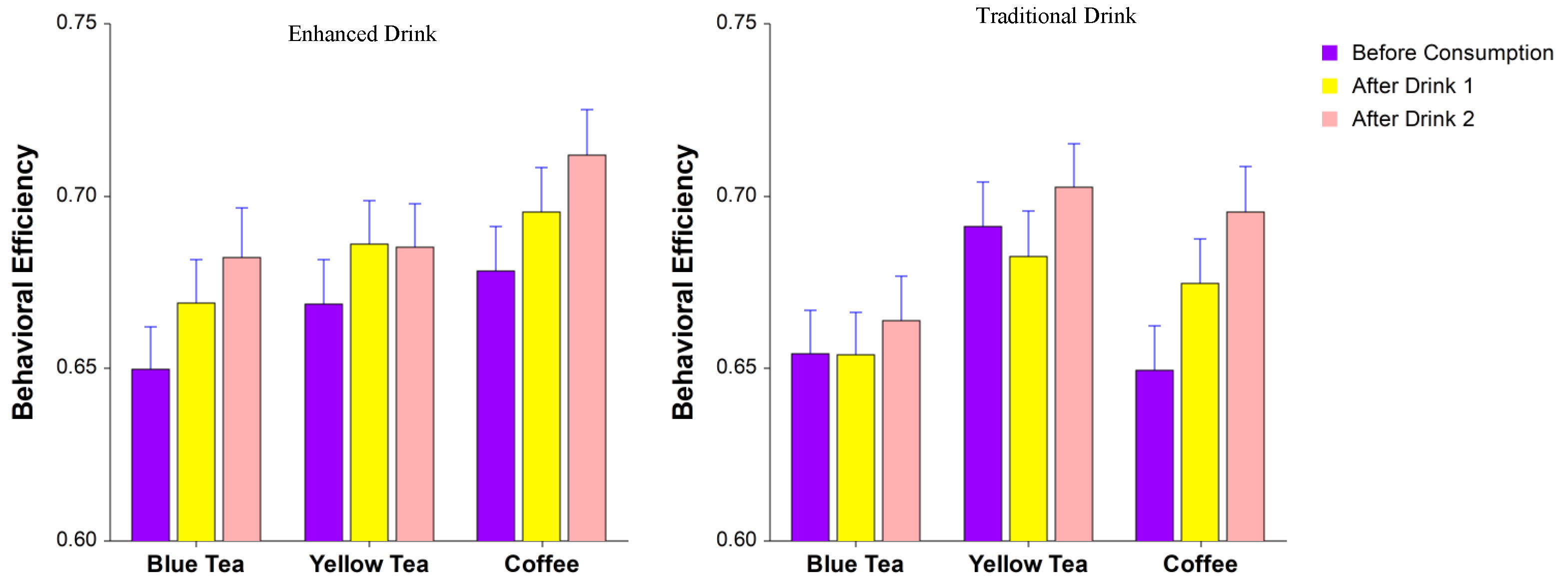
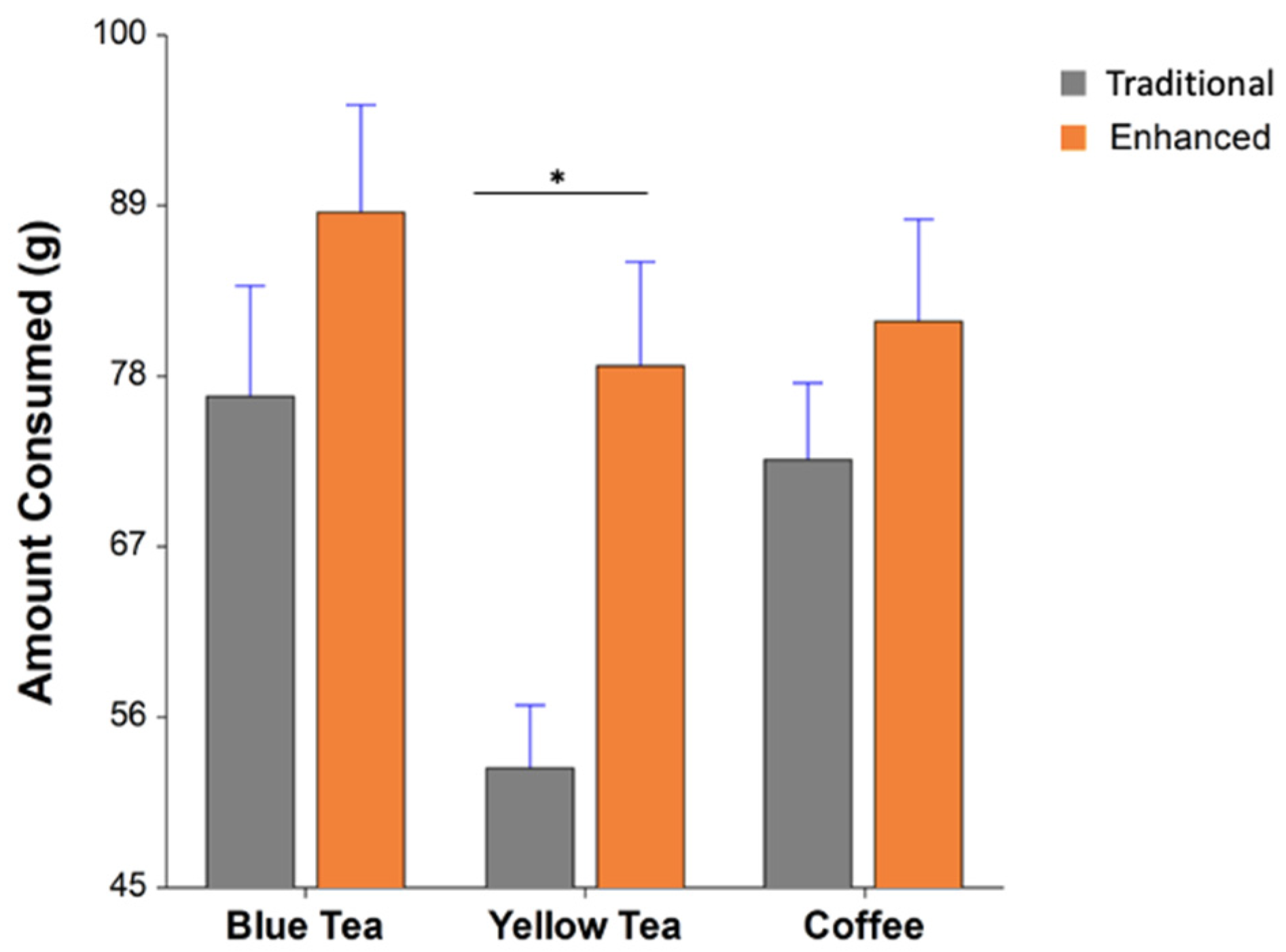
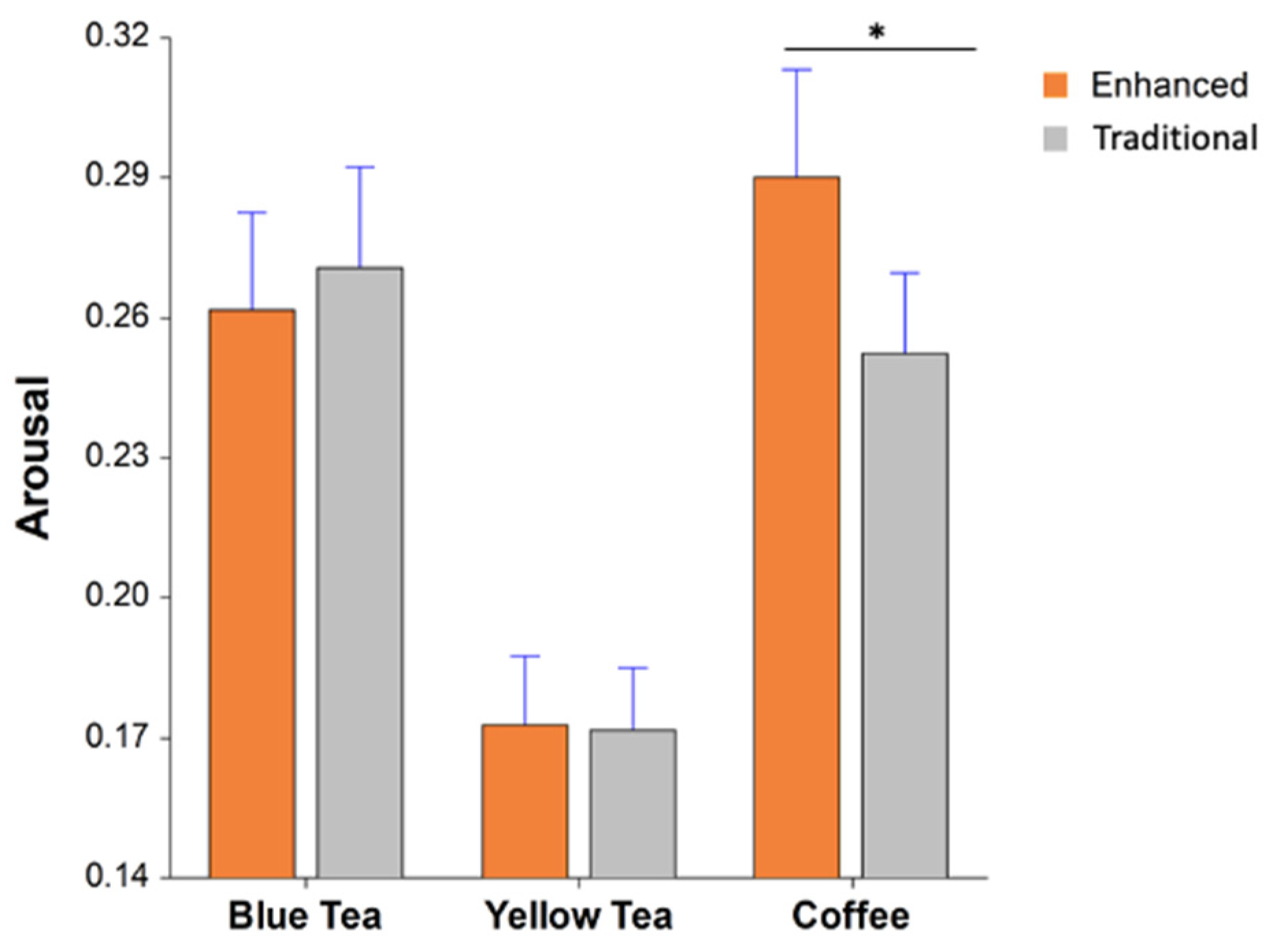
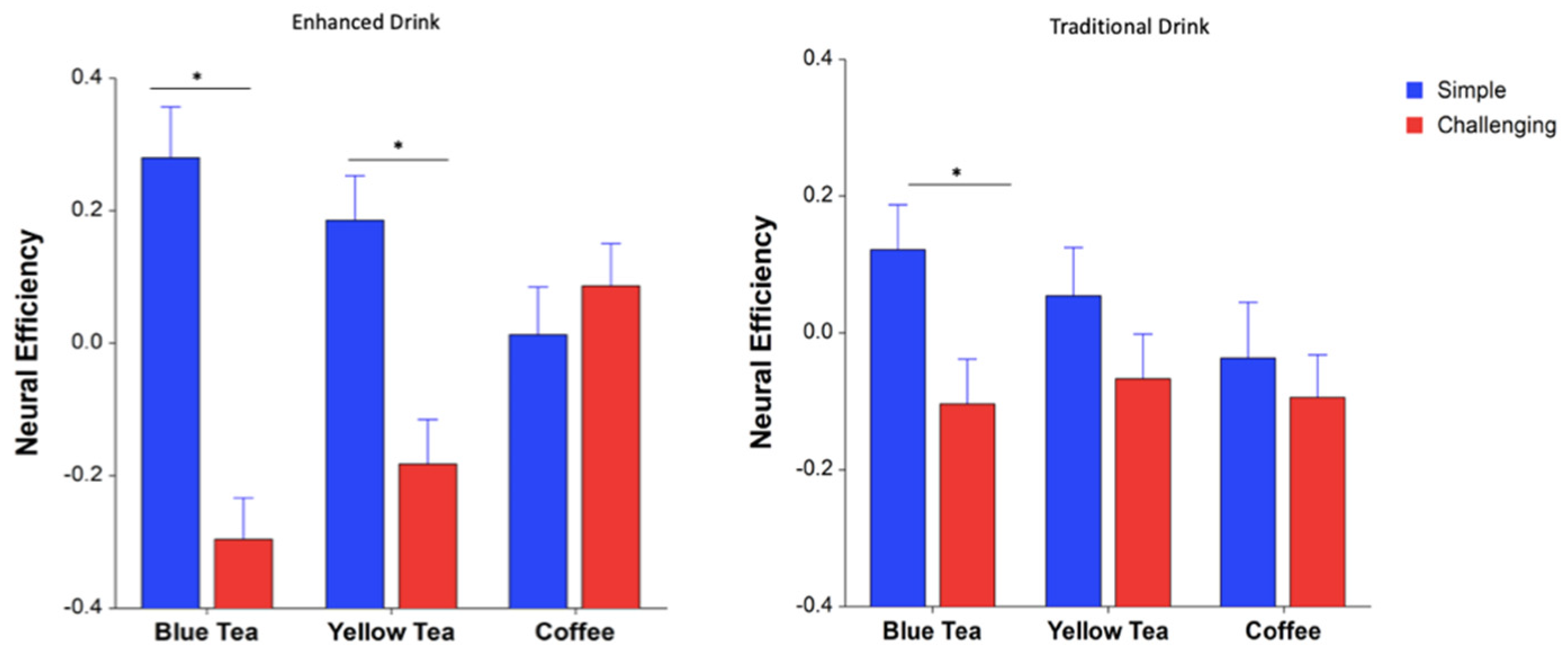
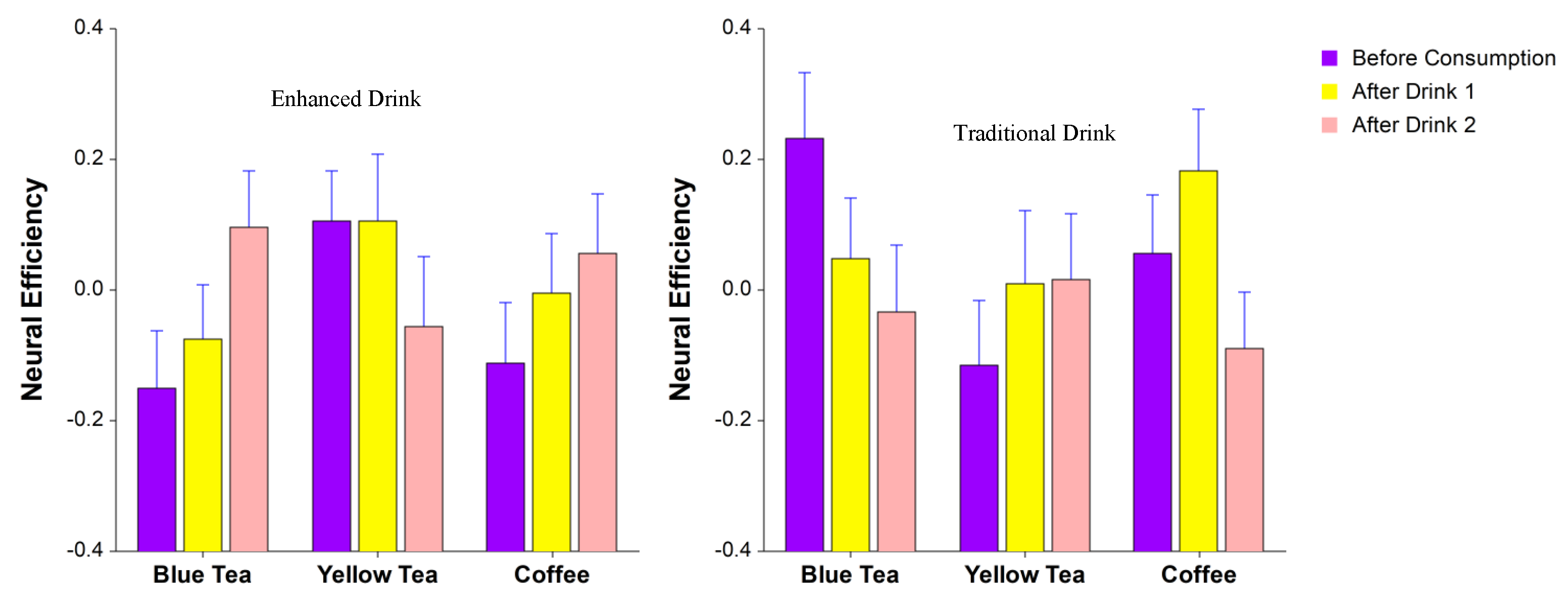
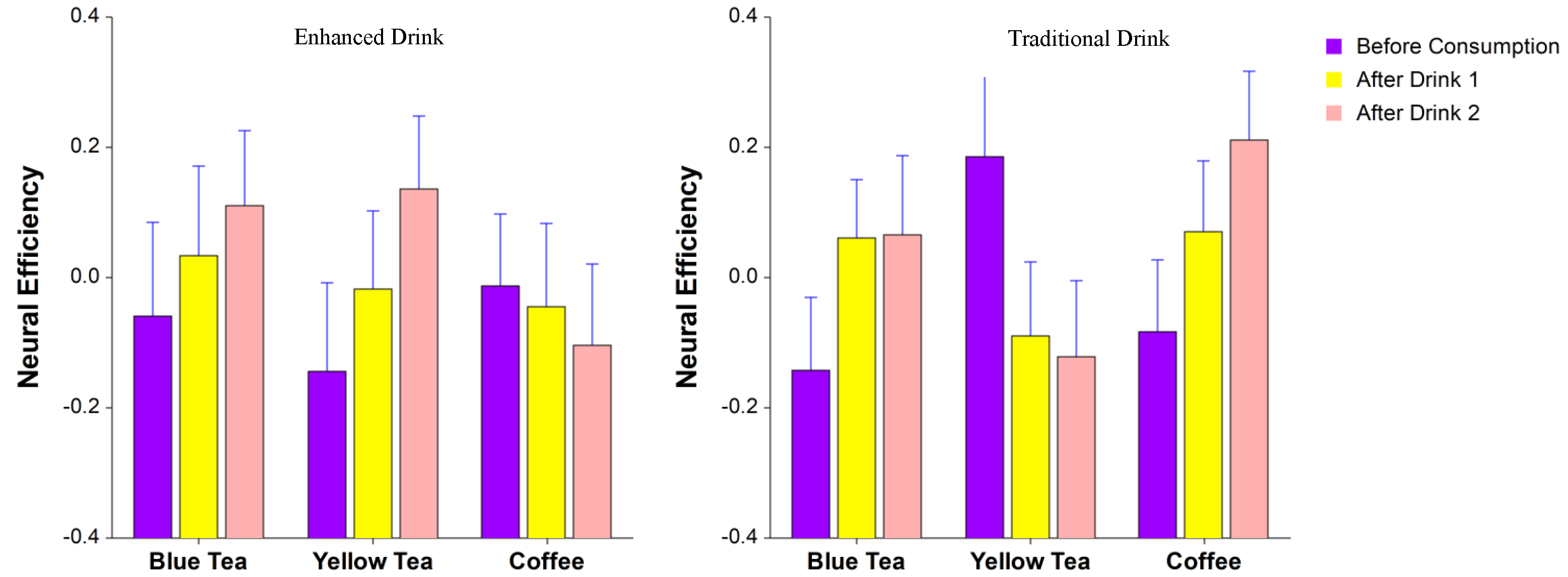
© 2020 by the authors. Licensee MDPI, Basel, Switzerland. This article is an open access article distributed under the terms and conditions of the Creative Commons Attribution (CC BY) license (http://creativecommons.org/licenses/by/4.0/).
Share and Cite
Sargent, A.; Watson, J.; Topoglu, Y.; Ye, H.; Suri, R.; Ayaz, H. Impact of Tea and Coffee Consumption on Cognitive Performance: An fNIRS and EDA Study. Appl. Sci. 2020, 10, 2390. https://doi.org/10.3390/app10072390
Sargent A, Watson J, Topoglu Y, Ye H, Suri R, Ayaz H. Impact of Tea and Coffee Consumption on Cognitive Performance: An fNIRS and EDA Study. Applied Sciences. 2020; 10(7):2390. https://doi.org/10.3390/app10072390
Chicago/Turabian StyleSargent, Amanda, Jan Watson, Yigit Topoglu, Hongjun Ye, Rajneesh Suri, and Hasan Ayaz. 2020. "Impact of Tea and Coffee Consumption on Cognitive Performance: An fNIRS and EDA Study" Applied Sciences 10, no. 7: 2390. https://doi.org/10.3390/app10072390
APA StyleSargent, A., Watson, J., Topoglu, Y., Ye, H., Suri, R., & Ayaz, H. (2020). Impact of Tea and Coffee Consumption on Cognitive Performance: An fNIRS and EDA Study. Applied Sciences, 10(7), 2390. https://doi.org/10.3390/app10072390





